Name Vanguard Laid down 2 April 1908 Construction started 2 April 1908 Length 163 m | Ordered 6 February 1908 Commissioned 1 March 1910 Draft 8.5 m Launched 22 February 1909 Builder Vickers-Armstrongs | |
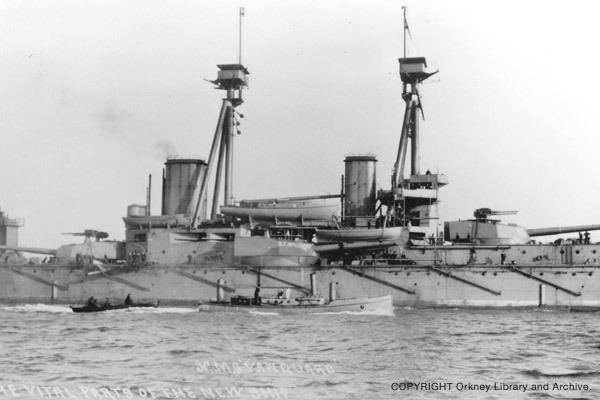 | ||
Fate Sunk by internal explosion at Scapa Flow, 9 July 1917 | ||
HMS Vanguard was one of three St Vincent-class dreadnought battleship built for the Royal Navy in the first decade of the 20th century. She spent her whole career assigned to the Home and Grand Fleets. Aside from participating in the Battle of Jutland in May 1916 several months later, and the inconclusive Action of 19 August, her service during the war generally consisted of routine patrols and training in the North Sea.
Contents
- Design and description
- Armament and armour
- Modifications
- Construction and career
- World War I
- Battle of Jutland
- Subsequent activity
- Explosion
- References
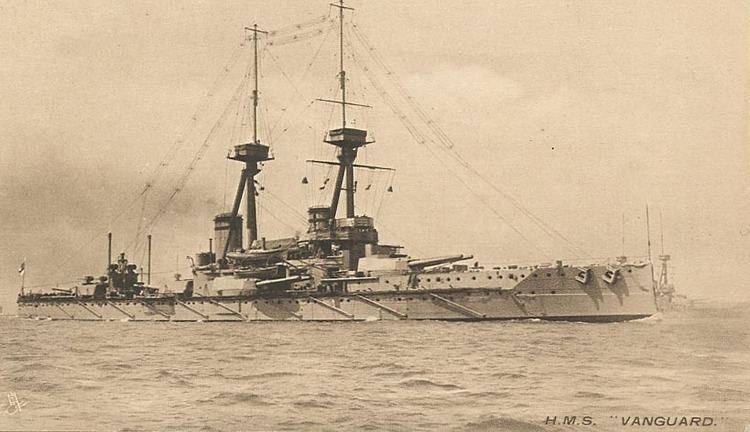
Shortly before midnight on 9 July 1917 at Scapa Flow, Vanguard suffered a series of magazine explosions. She sank almost instantly, with the loss of 843 of the 845 men aboard. As a war grave, the wreck has been designated as a controlled site under the Protection of Military Remains Act 1986 and diving on the wreck is generally forbidden.
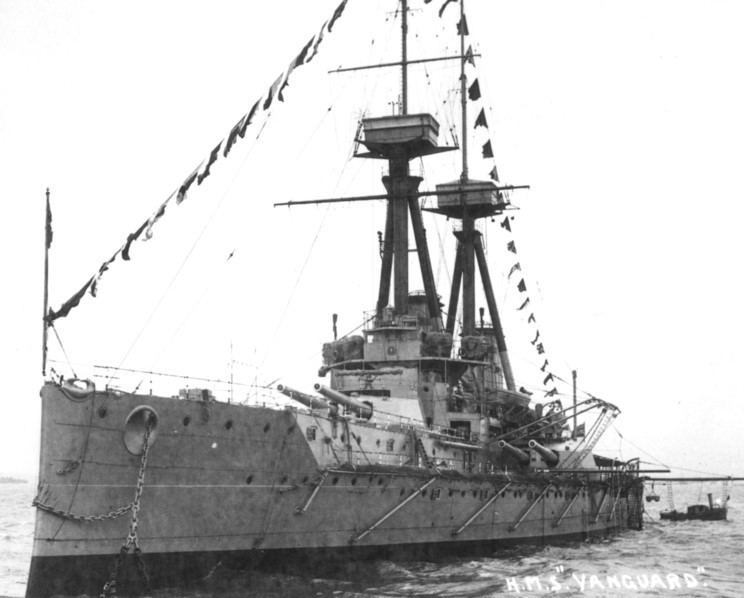
Design and description
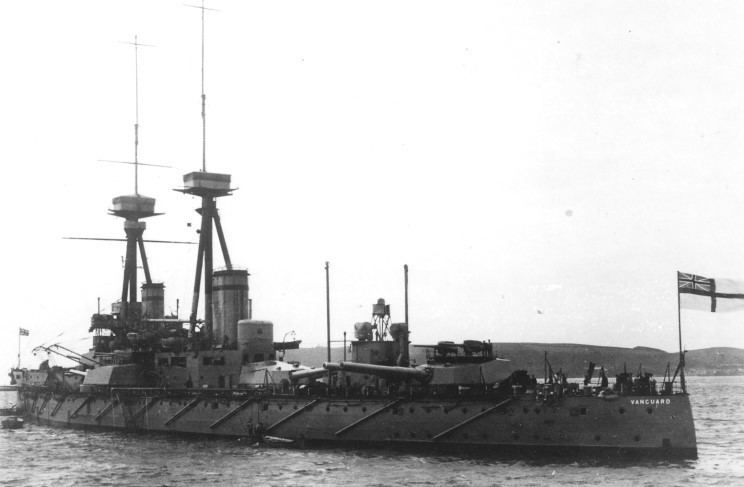
The design of the St Vincent class was derived from that of the previous Bellerophon class, with a slight increase in size, armour and more powerful guns, among other more minor changes. Vanguard had an overall length of 536 feet (163.4 m), a beam of 84 feet (25.6 m), and a normal draught of 28 feet (8.5 m). She displaced 19,700 long tons (20,000 t) at normal load and 22,800 long tons (23,200 t) at deep load. In 1910 her crew numbered 753 officers and ratings.
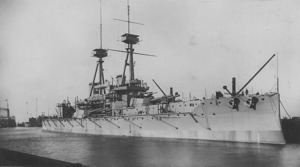
Vanguard was powered by two sets of Parsons direct-drive steam turbines, each driving two shafts, using steam from eighteen Babcock & Wilcox boilers. The turbines were rated at 24,500 shaft horsepower (18,300 kW) and intended to give the ship a maximum speed of 21 knots (39 km/h; 24 mph). During her sea trials on 17 December 1909, she unofficially reached a top speed of 22.3 knots (41.3 km/h; 25.7 mph) from 25,780 shaft horsepower (19,220 kW), although she must have been lightly loaded to reach this speed. Vanguard had a range of 6,900 nautical miles (12,800 km; 7,900 mi) at a cruising speed of 10 knots (19 km/h; 12 mph).
Armament and armour
The St Vincent class was equipped with ten breech-loading (BL) 12-inch (305 mm) Mk XI guns in five twin-gun turrets, three along the centreline and the remaining two as wing turrets. The centreline turrets were designated 'A', 'X' and 'Y', from front to rear, and the port and starboard wing turrets were 'P' and 'Q' respectively. The secondary, or anti-torpedo boat armament, comprised twenty BL 4-inch (102 mm) Mk VII guns. Two of these guns were each installed on the roofs of the fore and aft centreline turrets and the wing turrets in unshielded mounts, and the other ten were positioned in the superstructure. All guns were in single mounts. The ships were also fitted with three 18-inch (450 mm) torpedo tubes, one on each broadside and the third in the stern, and four 3-pounder (1.9 in (47 mm)) saluting guns.
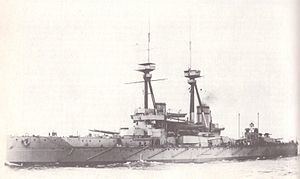
The St Vincent-class ships had a waterline belt of Krupp cemented armour (KC) that was 10 inches (254 mm) thick between the fore and aftmost barbettes that reduced to a thickness of 2 inches (51 mm) before it reached the ships' ends. Above this was a strake of armour 8 inches (203 mm) thick. Transverse bulkheads 5 to 8 inches (127 to 203 mm) thick terminated the thickest parts of the waterline and upper armour belts once they reached the outer portions of the endmost barbettes.
The three centreline barbettes were protected by armour 9 inches (229 mm) thick above the main deck that thinned to 5 inches (127 mm) below it. The wing barbettes were similar except that they had 10 inches of armour on their outer faces. The gun turrets had 11-inch (279 mm) faces and sides with 3 inches (76 mm) roofs. The three armoured decks ranged in thicknesses from .75 to 3 inches (19 to 76 mm). The front and sides of the forward conning tower were protected by 11-inch plates, although the rear and roof were 8 inches and 3 inches thick respectively.
Modifications
The guns on the forward turret roof were removed in 1910–1911. In 1913–1914, gun shields were fitted to most of the 4-inch guns in the superstructure and the bridge structure was enlarged around the base of the forward tripod mast. During the first year of the war, the base of the forward superstructure was rebuilt to house eight 4-inch guns and the turret-top guns were removed, which reduced her secondary armament to a total of fourteen guns. In addition a pair of 3-inch (76 mm) anti-aircraft (AA) guns were added. A fire-control director was installed high on the forward tripod mast before the Battle of Jutland in May 1916. Approximately 50 long tons (51 t) of additional deck armour were added afterwards. By April 1917, Vanguard mounted thirteen 4-inch anti-torpedo boat guns as well as single 4-inch and 3-inch AA guns.
Construction and career
Vanguard, eighth ship of that name to serve in the Royal Navy, was ordered on 6 February 1908. She was laid down by Vickers Armstrong at their Barrow-in-Furness shipyard on 2 April 1908, launched on 22 April 1909 and completed on 1 March 1910. Including her armament, her cost is variously quoted at £1,464,030 or £1,607,780. She was commissioned on 1 March 1910, under the command of Captain John Eustace, and assigned to the 1st Division of the Home Fleet. She was present in Torbay when King George V visited the fleet in late July. Vanguard also participated in the Coronation Fleet Review at Spithead on 24 June 1911 and she participated in exercises with the Atlantic Fleet the following month before beginning a refit. Captain Arthur Ricardo relieved Eustace on 23 September.
The ship was recommissioned on 28 March 1912 and rejoined the 1st Division before it was renamed the 1st Battle Squadron on 1 May. She participated in exercises with the 1st Fleet in October. Vanguard was refitted in December at which time new bilge keels were installed. On 5 June 1913, Captain Cecil Hickley replaced Ricardo upon the latter's promotion to commodore, second class.
World War I
Between 17 and 20 July 1914 Vanguard took part in a test mobilisation and fleet review as part of the British response to the July Crisis. Arriving in Portland on 27 July, she was ordered to proceed with the rest of the Home Fleet to Scapa Flow two days later to safeguard the fleet from a possible German surprise attack. In August 1914, following the outbreak of World War I, the Home Fleet was reorganised as the Grand Fleet, and placed under the command of Admiral John Jellicoe. On 1 September, the Grand Fleet was anchored at Scapa Flow when the light cruiser Falmouth spotted a suspected German submarine and provoked a panic across the fleet. Vanguard also spotted what was believed to be a periscope and opened fire, but the whole incident proved to be a false alarm. Submarine scares such as that one caused the fleet to be briefly based (22 October to 3 November) at Lough Swilly, Ireland, while the defences at Scapa were strengthened. On the evening of 22 November 1914, the Grand Fleet conducted a fruitless sweep in the southern half of the North Sea; Vanguard stood with the main body in support of Vice-Admiral David Beatty's 1st Battlecruiser Squadron. The fleet was back in port in Scapa Flow by 27 November. The 1st Battle Squadron cruised north-west of the Shetland Islands and conducted gunnery practice on 8–12 December. Four days later, the Grand Fleet sortied during the German raid on Scarborough, Hartlepool and Whitby, but failed to make contact with the High Seas Fleet. Vanguard and the rest of the Grand Fleet conducted another sweep of the North Sea on 25–27 December.
Jellicoe's ships, including Vanguard, conducted gunnery drills on 10–13 January 1915 west of the Orkneys and Shetlands. On the evening of 23 January, the bulk of the Grand Fleet sailed in support of Beatty's battlecruisers, but Vanguard and the rest of the fleet did not participate in the ensuing Battle of Dogger Bank the following day. On 7–10 March, the Grand Fleet conducted a sweep in the northern North Sea, during which it conducted training manoeuvres. Another such cruise took place on 16–19 March. On 11 April, the Grand Fleet conducted a patrol in the central North Sea and returned to port on 14 April; another patrol in the area took place on 17–19 April, followed by gunnery drills off the Shetlands on 20–21 April.
The Grand Fleet conducted sweeps into the central North Sea on 17–19 May and 29–31 May without encountering any German vessels. During 11–14 June, the fleet conducted gunnery practice and battle exercises west of the Shetlands and more training off the Shetlands beginning on 11 July. On 2–5 September, the fleet went on another cruise in the northern end of the North Sea and conducted gunnery drills. Throughout the rest of the month, the Grand Fleet conducted numerous training exercises. The ship, together with the majority of the Grand Fleet, conducted another sweep into the North Sea from 13 to 15 October. Almost three weeks later, Vanguard participated in another fleet training operation west of Orkney during 2–5 November.
The fleet departed for a cruise in the North Sea on 26 February 1916; Jellicoe had intended to use the Harwich Force to sweep the Heligoland Bight, but bad weather prevented operations in the southern North Sea. As a result, the operation was confined to the northern end of the sea. Another sweep began on 6 March, but had to be abandoned the following day as the weather grew too severe for the escorting destroyers. On the night of 25 March, Vanguard and the rest of the fleet sailed from Scapa Flow to support Beatty's battlecruisers and other light forces raiding the German Zeppelin base at Tondern. By the time the Grand Fleet approached the area on 26 March, the British and German forces had already disengaged and a strong gale threatened the light craft, so the fleet was ordered to return to base. In April the ship was transferred to the 4th Battle Squadron. On 21 April, the Grand Fleet conducted a demonstration off Horns Reef to distract the Germans while the Russian Navy relaid its defensive minefields in the Baltic Sea. The fleet returned to Scapa Flow on 24 April and refuelled before proceeding south in response to intelligence reports that the Germans were about to launch a raid on Lowestoft. The Grand Fleet arrived in the area after the Germans had withdrawn. On 2–4 May, the fleet conducted another demonstration off Horns Reef to keep German attention focused on the North Sea.
Battle of Jutland
In an attempt to lure out and destroy a portion of the Grand Fleet, the High Seas Fleet, composed of 16 dreadnoughts, 6 pre-dreadnoughts and supporting ships, departed the Jade Bight early on the morning of 31 May. The fleet sailed in concert with Rear Admiral Franz von Hipper's five battlecruisers. The Royal Navy's Room 40 had intercepted and decrypted German radio traffic containing plans of the operation. In response the Admiralty ordered the Grand Fleet, totalling some 28 dreadnoughts and 9 battlecruisers, to sortie the night before to cut off and destroy the High Seas Fleet.
On 31 May, Vanguard, now under the command of Captain James Dick, was the eighteenth ship from the head of the battle line after deployment. Shortly after deploying from column into line ahead, her crew logged shells from the High Seas Fleet were falling nearby. During the first stage of the general engagement, the ship fired 42 rounds from her main guns at the crippled light cruiser SMS Wiesbaden from 18:32, claiming several hits. Between 19:20 and 19:30, Vanguard engaged several German destroyer flotillas with her main armament without result. This was the last time that the ship fired her guns during the battle. She fired a total of 65 high explosive and 15 common pointed, capped, twelve-inch shells and 10 shells from her four-inch guns during the battle.
Subsequent activity
After the battle, the ship was transferred to the 4th Battle Squadron. On the evening of 18 August, the Grand Fleet put to sea in response to a message deciphered by Room 40 that indicated that the High Seas Fleet, minus II Squadron, would be leaving harbour that night. The German objective was to bombard Sunderland on 19 August, based on extensive reconnaissance conducted by Zeppelins and U-boats. The Grand Fleet sailed with 29 dreadnoughts and 6 battlecruisers while the Germans mustered 18 dreadnoughts and 2 battlecruisers. Throughout the next day, Jellicoe and Vice-Admiral Reinhard Scheer, commander of the High Seas Fleet, received conflicting intelligence; after reaching the location in the North Sea where they expected to encounter the High Seas Fleet, the British turned north in the erroneous belief that they had entered a minefield. Scheer turned south again, then steered south-eastward to pursue a lone British battle squadron sighted by an airship, which was in fact the Harwich Force. Realising their mistake, the Germans changed course for home. The only contact came in the evening when the British ships sighted the High Seas Fleet but was unable to achieve an advantageous attack position before dark, and broke off contact. The British and the German fleets returned home; the British lost two cruisers to U-boat attacks, and one German dreadnought had been torpedoed. After returning to port, Jellicoe issued an order that prohibited risking the fleet in the southern half of the North Sea due to the overwhelming risk from mines and U-boats unless the odds of defeating the High Seas Fleet in a decisive engagement were favourable.
Explosion
Vanguard was refitted in Rosyth in December. On the afternoon of 9 July 1917, the ship's crew had been exercising, practising the routine for abandoning ship. She anchored in the northern part of Scapa Flow at about 18.30. There is no record of anyone detecting anything amiss until the first explosion at 23:20. She sank almost instantly, with only three of the crew surviving, one of whom died soon afterwards. A total of 840 crewmen were lost, plus two Australian stokers from the light cruiser HMAS Sydney serving time in the battleship's brig. One of the casualties of the disaster was Captain Kyōsuke Eto, a military observer from the Imperial Japanese Navy, which was allied with the Royal Navy at the time through the Anglo-Japanese Alliance. The bodies of 17 of the 22 men recovered after the explosion, plus that of Lieutenant-Commander Albert Duke, who died after being rescued, were buried at the Royal Naval Cemetery at Lyness, not far from the site of the explosion. The others are commemorated on the Chatham, Plymouth Naval Memorial|Plymouth and Portsmouth Naval Memorials.
A board of inquiry heard accounts from many witnesses on nearby ships. They accepted the consensus that there had been a small explosion with a white glare between the foremast and 'A' turret, followed after a brief interval by two much larger explosions. The board decided, on the balance of the available evidence, that the main detonations were in either 'P' magazine, 'Q' magazine, or both. A great deal of debris thrown out by the explosion landed on nearby ships; a section of plating measuring approximately six by four feet (1.8 by 1.2 m) landed on board the battleship Bellerophon. It was found to be from the No. 2 Hydraulic Room abaft 'A' barbette. It showed no signs of a blast from 'A' magazine, which reinforced the visual evidence suggesting that the explosion took place in the central part of the ship.
Although the explosion was obviously an explosion of the cordite charges in a main magazine, the reason for it was much less obvious. There were several theories. The inquiry found that some of the cordite on board, which had been temporarily offloaded in December 1916 and catalogued at that time, was past its stated safe life. The possibility of spontaneous detonation was raised, but could not be proved. It was also noted that a number of ship's boilers were still in use, and some watertight doors which should have been closed in war-time, were open as the ship was in port. It was suggested that this might have contributed to a dangerously high temperature in the magazines. The final conclusion of the board was that a fire started in a four-inch magazine, perhaps when a raised temperature caused spontaneous ignition of cordite, spreading to one or the other main magazines, which then exploded.
The wreck was heavily salvaged in search of non-ferrous metals before it was declared a war grave in 1984, although some of the main armament and armour plate were also removed. As might be expected the wreck, which lies at a depth of 14.2 metres (46 ft 7 in), and its associated debris cover a large area at 58.8566°N 3.1062°W / 58.8566; -3.1062. The amidships portion of the ship is almost completely gone and 'P' and 'Q' turrets were blown some 40 metres (130 ft) away. The bow and stern areas are almost intact as has been revealed by a survey authorised by the Ministry of Defence in 2016 in preparation for the centenary commemoration planned for 2017. The wreck was designated as a controlled site in 2002 and cannot be dived upon except with permission from the Ministry of Defence.
